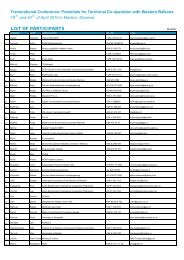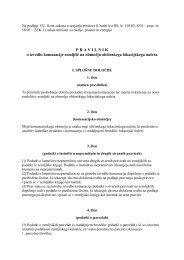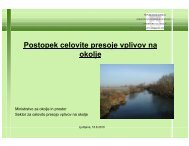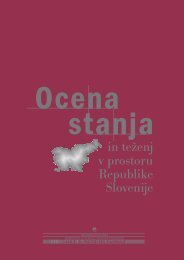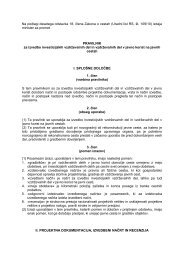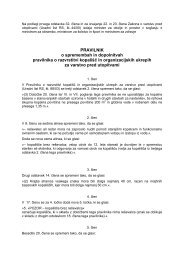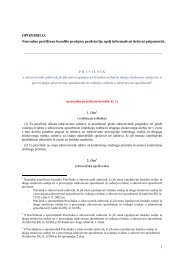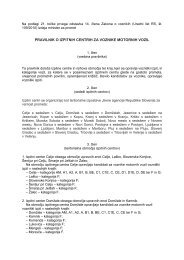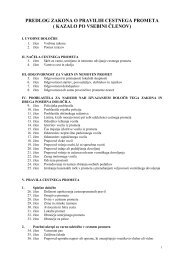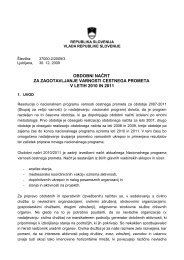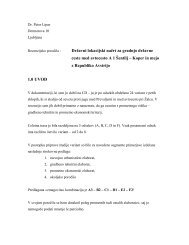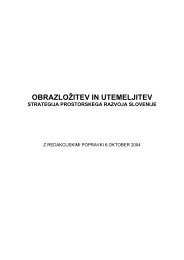evropska konvencija o krajini - Ministrstvo za infrastrukturo in prostor
evropska konvencija o krajini - Ministrstvo za infrastrukturo in prostor
evropska konvencija o krajini - Ministrstvo za infrastrukturo in prostor
You also want an ePaper? Increase the reach of your titles
YUMPU automatically turns print PDFs into web optimized ePapers that Google loves.
the processes of enculturation. Thus landscapefeatures act as message carriers. A number ofsuch conceptions <strong>in</strong>fluence our relationship withthis environment, our behaviour and the conceptionswe convey to others. The process is repetitive,mean<strong>in</strong>g that landscape are evaluated andtransformed accord<strong>in</strong>g to a certa<strong>in</strong> generallyaccepted, idealized image, which does not necessarilymatch<strong>in</strong>g the spatial reality.46Delavnica 1 / Workshop 13. Razglednica »Rodna gruda« (Maksim Gaspari) iz časa pred drugosvetovno vojno.Rodna gruda (»Native soil«) by Maksim Gaspari, pre-World War IIpostcard.<strong>prostor</strong>u/<strong>kraj<strong>in</strong>i</strong>, da pa lahko ob njih mirno <strong>in</strong>brez konfliktov sprejemajo tudi družbenosplošno sprejete predstave. To je zelo jasnopoka<strong>za</strong>la raziskava, opravljena leta 1995 naprimeru Slovenije, potrdilo pa jo je tudi pilotskopreizkušanje pred nekaj leti (2002). Rezultati izjavnega mnenja so potrdili ugotovitve izsemiološke analize likovnih predstavitevslovenskega <strong>prostor</strong>a v turistični <strong>in</strong> političnipropagandi. Poka<strong>za</strong>li so, da se identiteta niopredeljevala samo s simbolnimi kraji, temvečtudi s posebnimi kraj<strong>in</strong>skimi tipi, ki epitomizirajonacionalni <strong>prostor</strong> 5 .Pridobivanje spoznanj o družbeni <strong>za</strong>znav<strong>in</strong>acionalnega <strong>prostor</strong>a oziroma kraj<strong>in</strong>skeidentitete ozemlja, na katerem živimo, pa se ni<strong>za</strong>dovoljilo le z iskanjem fenomenoloških vidikovnacionalne topografije, temveč je prodrlo tudi vvzročno-posledične soodvisnosti <strong>in</strong> razkrilovzroke <strong>in</strong> procese, ki pri nas usmerjajo <strong>prostor</strong>skirazvoj <strong>in</strong> s katerimi se ustvarja predstava oistovetnosti slovenskih kraj<strong>in</strong>. Ta namreč izhajaiz naše (narodove) samoopredelitve, iz našegaskupnega dojemanja <strong>prostor</strong>a, v katerem živimo<strong>in</strong> sledi vrednostnim opredelitvam, določenim združbenim sistemom simbolov, nastalih v skupnikulturni zgodov<strong>in</strong>i. Slovenija je <strong>za</strong>to odličenprimer <strong>za</strong>radi dveh razlogov. Prvič, ker se jekoncem 20. stoletja ponovno pojavila potrebapo utrjevanju nacionalne identitete, ki je <strong>za</strong> svojcilj uporabljala tudi kraj<strong>in</strong>ske podobe <strong>in</strong>prispodobe <strong>in</strong> je bilo vlogi kraj<strong>in</strong>e v nacionalnimitologiji lahko slediti <strong>in</strong> situ <strong>in</strong> drugič, ker setakoj izpostavi vprašanje, ali je ob izpričani(stvarni) geografski <strong>in</strong> kulturni raznolikostislovenskega ozemlja sploh možen (<strong>in</strong> ustrezen)obstoj ene <strong>in</strong> enotne, časovno stabilne <strong>in</strong> sWhy the use of plural <strong>in</strong> the term conception?None of these conceptions is an absolute category;they can replace each other <strong>in</strong> the currentlypredom<strong>in</strong>ant position. Now one and thenanother significance layer of the conceptioncome to the fore. This means there are certa<strong>in</strong>lymore conceptions of space, which differ with<strong>in</strong>social groups and ga<strong>in</strong> their importance accord<strong>in</strong>gto specific current needs. Needs are not onlypragmatic; they are also ideological, such as theneed for establish<strong>in</strong>g or preserv<strong>in</strong>g national identity;they are topical at certa<strong>in</strong> moments: they areneither <strong>in</strong>herent nor ord<strong>in</strong>ary. The research onthe modern social conception of Slovene spaceclearly revealed that <strong>in</strong>dividuals, while hav<strong>in</strong>gtheir own conceptions of the environment, caneasily and without any conflicts adopt generallyaccepted social conceptions 5 . The results of thepublic op<strong>in</strong>ion survey confirmed the f<strong>in</strong>d<strong>in</strong>gs ofa semiotic analysis of pictorial presentations oflandscapes <strong>in</strong> tourist and political propaganda.They showed that <strong>in</strong> course of history, nationalidentity is def<strong>in</strong>ed not only by symbolic placesbut also by special landscape types that epitomizethe national space.While attempt<strong>in</strong>g to understand the social perceptionof national space – of the landscapeidentity of the territory of a certa<strong>in</strong> nation – thesearch for the phenomenological issues of nationaltopography was not <strong>in</strong> itself satisfactory.It was necessary to penetrate the causal<strong>in</strong>terdependencies and reveal motifs, causesand processes that direct spatial developmentand are basic constituents of the concept of thespatial identity of Slovenian landscapes. Thisconcept emerges from the national self-def<strong>in</strong>ition,from mutual and collective spatial perceptionsand follows the social system of values thatwas developed <strong>in</strong> common cultural history.Slovenia made an excellent case for such astudy for two reasons. First, at the end of thetwentieths century the needs for a re<strong>in</strong>forcementof a national identity came for various reasons(aga<strong>in</strong>) to the fore and while landscape



